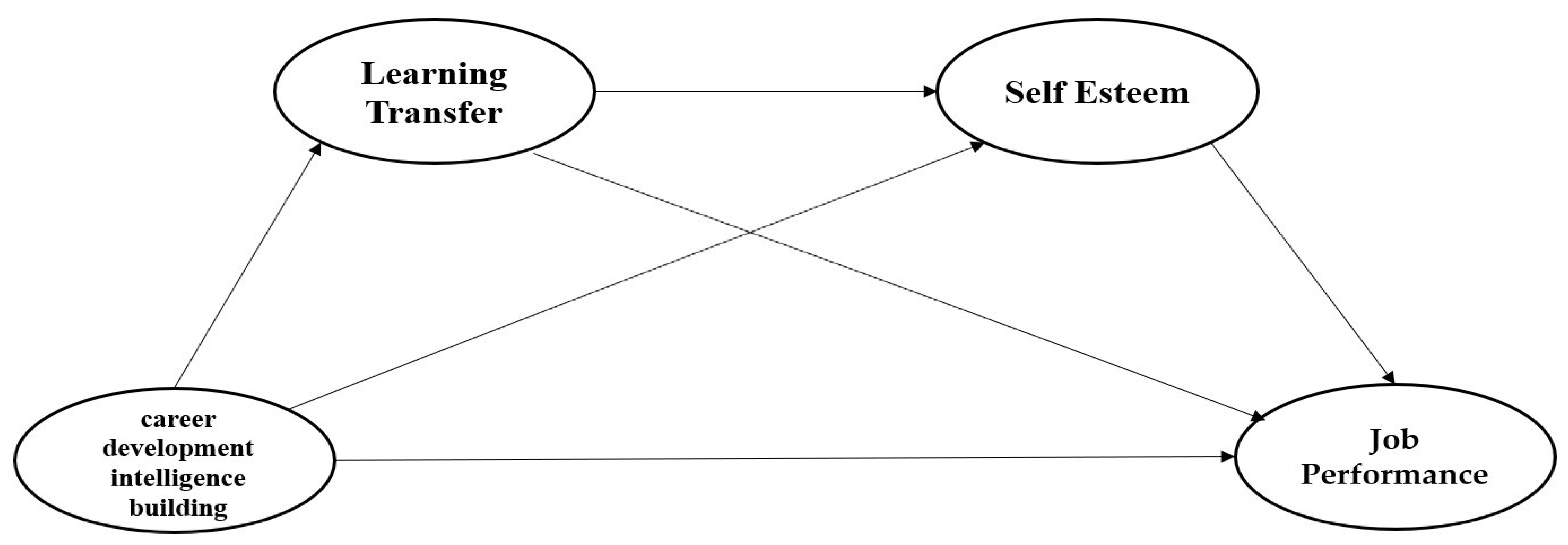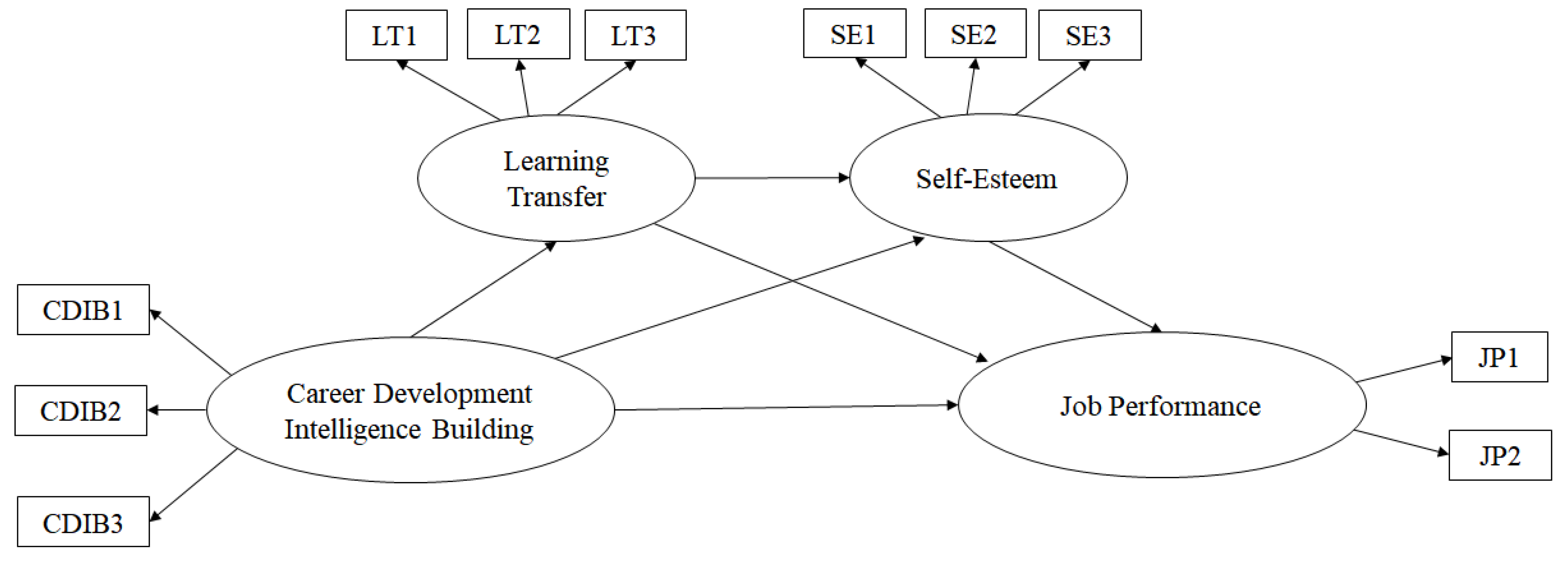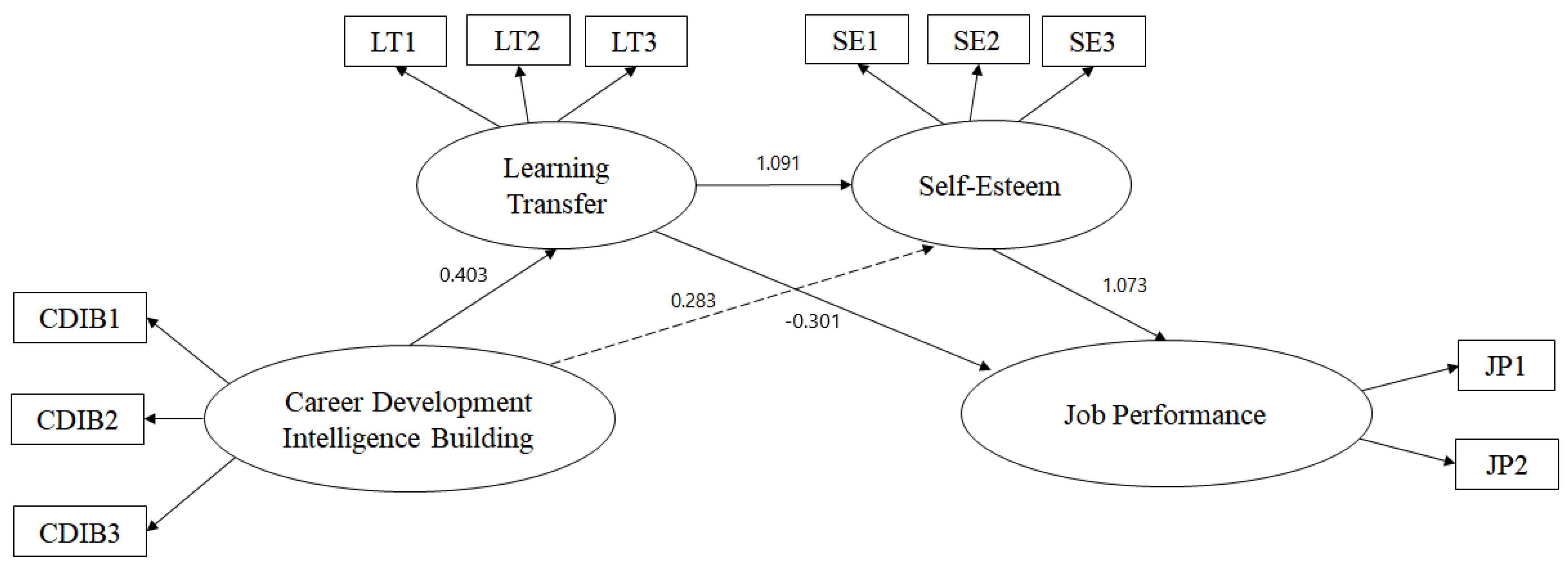Influence of Support for Career Development Intelligence Building for College Graduates on their Job Performance: The Case of South Korea
Abstract
:1. Introduction
2. Review of Literature
2.1. Support for Career Development Intelligence Building
2.2. Self-Esteem
2.3. Learning Transfer
2.4. Job Performance
2.5. Support for Career Development Intelligence Building and Job Performance
2.6. The Mediating Role of Learning Transfer and Self-Esteem between Support for Career Development Intelligence Building and Job Performance
3. Research Methodology
3.1. Research Model
3.2. Participants
3.3. Measures
3.4. Data Analysis and Research Procedures
4. Research Results
5. Discussion
Author Contributions
Funding
Institutional Review Board Statement
Informed Consent Statement
Data Availability Statement
Conflicts of Interest
References
- Kim, J.; Bates, R.A.; Song, J.H. Validation of the Learning Transfer System Inventory (LTSI) in the Korean corporate context. Hum. Resour. Dev. Int. 2019, 22, 217–234. [Google Scholar] [CrossRef]
- Jang, Y.O.; Jeong, S.L. Moderating effects of self-regulated learning strategies on the relation between academic stress, academic burnout and academic engagement in adolescents. Second. Educ. Res. 2017, 65, 195–223. [Google Scholar] [CrossRef]
- Fredricks, J.A.; Blumenfeld, P.C.; Paris, A.H. School engagement: Potential of the concept, state of the evidence. Rev. Educ. Res. 2004, 74, 59–109. [Google Scholar] [CrossRef]
- Ha, H.S.; Lim, H.J.; Hwang, M.H. The group difference of grit and self-control and its relations to school maladjustment, academic achievement, and predictability of personality. J. Lifelong Learn. Soc. 2015, 11, 145–166. [Google Scholar] [CrossRef]
- Kim, S.Y.; Song, K.H. A study on structural relations between teacher-student interactions, outcome expectancy and academic engagement in physical education classes. J. Korea Converg. Soc. 2019, 10, 303–309. [Google Scholar] [CrossRef]
- Kim, Y.S. Correlation Research between Self-Directed Learning, Self-Esteem and Creativity to Academic Achievement Level. Master’s Thesis, Gwangju National University, Gwangju, Korea, 2018. [Google Scholar]
- Noe, R.A. Trainees’ attributes and attitudes: Neglected influences on training effectiveness. Acad. Manag. Rev. 1986, 11, 736–749. [Google Scholar] [CrossRef]
- Lee, J.R.; Kwon, D.H. An analysis of structural relationship among locus of control, mindset, grit, and academic achievement. Korean J. Youth Stud. 2016, 23, 245–264. [Google Scholar] [CrossRef]
- Lee, S.R. Effects of Grit, Deliberate Practice and Contingencies of Self-Worth on Academic Achievement. Ph.D. Thesis, Yonsei University, Incheon, Korea, 2015. [Google Scholar]
- Kim, H.W.; Jang, Y.O. The influence of adolescents’ academic stress on academic burnout and academic engagement: Focusing on the moderating effects of parental academic involvement behavior. J. Korean Home Manag. Assoc. 2016, 34, 99–117. [Google Scholar] [CrossRef]
- Jo, H.I.; Lee, H.A. The Mediating Effects of Achievement Goals on the Relationship among Perfectionism, Academic Burnout and Academic Engagement. Korean J. Youth Stud. 2013, 17, 131–153. [Google Scholar]
- Kahn, W.A. Psychological conditions of personal engagement and disengagement at work. Acad. Manag. J. 1990, 33, 692–724. [Google Scholar] [CrossRef]
- Jo, S.H.; Lee, M.Y.; Lee, J.H.; Lee, S.M. Study on academic burnout and engagement among high school students: Applying the job demands-resources model. Korea Educ. Rev. 2018, 24, 1–26. [Google Scholar] [CrossRef]
- Kim, S.S.; Han, H.R. An analysis on the Practice of Middle School Sexual education and the Demand of Sexual Education by Sex. J. Educ. Stud. 2005, 36, 125–141. [Google Scholar]
- Baldwin, T.T.; Kevin Ford, J.; Blume, B.D. The State of Transfer of Training Research: Moving Toward More Consumer-Centric Inquiry. Hum. Resour. Dev. Q. 2017, 28, 17–28. [Google Scholar] [CrossRef]
- Lee, Y.; Lee, J.Y. A multilevel analysis of individual and organizational factors that influence the relationship between career development and job-performance improvement. Eur. J. Train. Dev. 2018, 42, 286–304. [Google Scholar] [CrossRef]
- Robinson, D.G.; Robinson, T.C. Training for Impact: How to Link Training to Business Needs and Measure the Results; Jossey-Bass: San Francisco, CA, USA, 1989. [Google Scholar]
- Tracey, J.B.; Hinkin, T.R.; Tannebaum, S.I.; Mathieu, J.E. The influence of individual characteristics and the work environment on varying levels of training outcomes. Hum. Resour. Dev. Q. 2001, 12, 5–23. [Google Scholar] [CrossRef]
- Elliot, A.J.; Church, M.A. A hierarchical model of approach and avoidance achievement motivation. J. Personal. Soc. Psychol. 1997, 72, 218. [Google Scholar] [CrossRef]
- Charness, N.; Tuffiash, M.I.; Krampe, R.T.; Reingold, E.; Vasyukova, E. The role of deliberate practice in chess expertise. Appl. Cogn. Psychol. 2005, 19, 151–165. [Google Scholar] [CrossRef]
- Kim, B.J.; Jeon, S.Y.; Chio, J. A study on the effect of studying immersion and class satisfaction on aviation cadets’ re-taking the class according to teacher’s teaching behaviors of the martial arts class. Korea J. Sports Sci. 2013, 22, 299–316. [Google Scholar]
- Egan, T.M.; Upton, M.G.; Lynham, S.A. Career development: Load-bearing wall or window dressing? Exploring definitions, theories, and prospects for HRD-related theory building. Hum. Resour. Dev. Rev. 2006, 5, 442–477. [Google Scholar] [CrossRef]
- Kim, G.S. Analysis of Causal Circulation Structure of Academic Achievement Using System Dynamics and Development of Predictive Model. Ph.D. Thesis, Konkuk University, Seoul, Korea, 2012. [Google Scholar]
- Han, S.C. The Mediating Effect of Academic Self-Efficacy on the Relationship Between Grit and Academic Achievement of the University Students. Master’s Thesis, Chonbuk National University, Jeonju, Korea, 2017. [Google Scholar]
- Handelsman, M.M.; Briggs, W.L.; Sullivan, N.; Towler, A. A measure of college student course engagement. J. Educ. Res. 2005, 98, 184–192. [Google Scholar] [CrossRef]
- Noe, R.A.; Schmitt, N. The influence of trainee attitudes on training effectiveness: Test of a model. Pers. Psychol. 1986, 39, 497–521. [Google Scholar] [CrossRef]
- Holton, E.F. The flawed four level evaluation model. Hum. Resour. Dev. Q. 1996, 7, 5–21. [Google Scholar] [CrossRef]
- Hwang, M.H.; Sun, H.Y.; Jung, A.K.; Kim, D.J.; Kim, Y.B. Academic Failure Process and Response of Students with Excellence who have experienced a decline in their grades. Asian J. Educ. 2009, 10. [Google Scholar]
- Gu, M.S. The Effect of Competitive or Non-Competitive Cooperative Learning Class Strategies on Learning Motivation and Exercise Performance. Master’s Thesis, Korea National Sport University, Seoul, Korea, 2006. [Google Scholar]
- Almqvist, L.; Uys, C.J.E.; Sandberg, A. The concepts of participation, engagement and flow: A matter of creating optimal play experiences. South Afr. J. Occuptional Ther. 2007, 37, 8–13. [Google Scholar]
- Bae, S.H.; Kim, H.J. Validation of the national survey of student engagement (NSSE) Model in the Korean context. J. Educ. Adm. 2012, 30, 499–523. [Google Scholar] [CrossRef]
- Coopersmith, S. The Antecedents of Self-Esteem; W. H. Freeman: San Francisco, CA, USA, 1967. [Google Scholar]
- Duckworth, A.L.; Gross, J.J. Self-control and grit: Related but separable determinants of success. Curr. Dir. Psychol. Sci. 2014, 23, 319–325. [Google Scholar] [CrossRef]
- Duckworth, A.L.; Peterson, C.; Matthews, M.D.; Kelly, D.R. Grit: Perseverance and passion for long-term goals. J. Personal. Soc. Psychol. 2007, 92, 1087–1101. [Google Scholar] [CrossRef]
- Choi, I.J.; Oh, S.Y. Analysis on structural relationship of influential factors on adolescent’s academic achievement: Focused on parents’ support, self-esteem and school adjustment. J. Future Oriented Youth Soc. 2010, 7, 95–113. [Google Scholar]
- Datu, J.A.D.; King, R.B.; Valdez, J.P.M.; Eala, M.S.M. Grit is associated with lower depression via meaning in life among Filipino high school students. Youth Soc. 2019, 51, 865–876. [Google Scholar] [CrossRef]
- Furrer, C.; Skinner, E. Sense of factor in children’s academic engagement and relatedness as a performance. J. Educ. Psychol. 2003, 95, 148–162. [Google Scholar] [CrossRef]
- González-Romá, V.; Schaufeli, W.B.; Bakker, A.B.; Lloret, S. Burnout and work engagement: Independent factors or opposite poles? J. Vocat. Behav. 2006, 68, 165–174. [Google Scholar] [CrossRef]
- Hyung, M.J. The Influence of Self-Esteem and Academic Achievement on Career Maturity. Master’s Thesis, Ewha Womens University, Seoul, Korea, 2002. [Google Scholar]
- Youn, T.H.; Cho, Y.I. Longitudinal mediated effects of self-esteem and depression on the relation between parent-child attachment and suicidal ideation. Korean J. Dev. Psychol. 2014, 27, 61–90. [Google Scholar]
- Yeon, M.H. Youth Understanding and Guidance; Haneul: Seoul, Korea, 1994. [Google Scholar]
- Vainio, M.M.; Daukantaitė, D. Grit and different aspects of well-being: Direct and indirect relationships via sense of coherence and authenticity. J. Happiness Stud. 2016, 17, 2119–2147. [Google Scholar] [CrossRef]
- Son, Y.W. Experts, Their Own Laws; Samtersa: Seoul, Korea, 2005. [Google Scholar]
- Yang, N.M.; Park, H.J.; Lee, D.G. The relationship between warm parenting style and children`s interpersonal conflict-resolution ability in middle school students. Korea J. Couns. 2014, 15, 1515–1529. [Google Scholar] [CrossRef]
- Lee, S.R.; Sohn, Y.W. What are the strong predictors of academic achievement? Deliberate practice and Grit. Korean J. Sch. Psychol. 2013, 10, 349–366. [Google Scholar]
- Lee, S.S.; Cho, H.S. The effects of subject interest in physical education classes on academic engagement among students. Korean Soc. Sports Sci. 2015, 24, 855–867. [Google Scholar]
- Skinner, E.A.; Wellborn, J.G.; Connell, J.P. What it takes to do well in school and whether I’ve got it: A process model of perceived control and children’s engagement and achievement in school. J. Educ. Psychol. 1990, 82, 22. [Google Scholar] [CrossRef]
- Singh, K.; Jha, S.D. Positive and negative affect and grit as predictors of happiness and life satisfaction. J. Indian Acad. Appl. Psychol. 2008, 34, 40–45. [Google Scholar]
- Shin, Y.I.; Kang, T.S. The effects of social withdrawal on academic engagement: Focusing on the medium effect of self-esteem. J. Learn. Cent. Curric. Instr. 2020, 20, 911–932. [Google Scholar] [CrossRef]
- Leiter, M.P.; Harvie, P. Correspondence of supervisor and subordinate perspectives during major organizational change. J. Occup. Health Psychol. 1997, 2, 343. [Google Scholar] [CrossRef]
- Lim, H.J.; Hwang, M.H.; Ha, H.S. The relationship among grit, self-efficacy, achievement goal, and academic self-regulation in elementary school children. J. Educ. Stud. 2016, 47, 43–65. [Google Scholar] [CrossRef]
- McFarlin, D.B.; Blascovich, J. Effects of self-esteem and performance feedback on future affective preferences and cognitive expectations. J. Personal. Soc. Psychol. 1981, 40, 521–531. [Google Scholar] [CrossRef]
- Seo, W.S.; Jang, J.H.; Kim, S.W. A longitudinal study on the self-esteem, curriculum self-efficacy, and academic achievement of middle school students. J. Educ. Cult. 2020, 26, 625–649. [Google Scholar] [CrossRef]
- Shechtman, N.; DeBarger, A.H.; Dornsife, C.; Rosier, S.; Yarnall, L. Promoting grit, tenacity, and perseverance: Critical factors for success in the 21st century. U.S. Dep. Educ. Technol. 2013, 2013, 5–107. [Google Scholar]
- Schaufeli, W.B.; Martez, I.M.; Pinto, A.M.; Salanova, M.; Bakker, A.B. Burnout and engagement in university students: A cross-national study. J. Cross-Cult. Psychol. 2002, 33, 464–481. [Google Scholar] [CrossRef]
- Moon, M.H. The Mediated Effect of Self-Esteem on the Risk Factors that Affect to the Perceived Academic Achievement of Adolescent. Ph.D. Thesis, Youngnam University, Gyeongsan, Korea, 2016. [Google Scholar]
- Natale, K.; Aunola, K.; Nurmi, J.E. Children’s school performance and their parents’ causal attributions to ability and effort: A longitudinal study. J. Appl. Dev. Psychol. 2009, 30, 14–22. [Google Scholar] [CrossRef]
- Mosher, R.; MacGowan, B. Assessing Student Engagement in Secondary Schools: Alternative Conceptions, Strategies of Assessing, and Instruments; Institute of Education Sciences: Washington, DC, USA, 1985. [Google Scholar]
- Park, S.M. The effect of health conditions on the satisfaction of life in older adults: The mediating effect of social participation and economic activities. Welf. Elder. Focusing Eff. Dep. Regul. 2011, 53, 305–332. [Google Scholar]
- Rosenberg, M. Society and the Adolescent Self-Image; Princeton University Press: Princeton, NJ, USA, 1965. [Google Scholar] [CrossRef]
- Ryu, H.J. Effects of Art Therapy on Improvement of Adolescents’ Self-Esteem. Master’s Thesis, Dongguk University, Seoul, Korea, 2010. [Google Scholar] [CrossRef]
- Ericsson, K.A. Towards a procedure for eliciting verbal expression of non-verbal experience without reactivity: Interpreting the verbal overshadowing effect within the theoretical framework for protocol analysis. Appl. Cogn. Psychol. 2002, 16, 981–988. [Google Scholar] [CrossRef]
- Salles, A.; Cohen, G.L.; Mueller, C.M. The relationship between grit and resident well-being. Am. J. Surg. 2014, 207, 251–254. [Google Scholar] [CrossRef]
- London, M.; Noe, R.A. London’s Career Motivation Theory: An Update on Measurement and Research. J. Career Assess. 1997, 5, 61–80. [Google Scholar] [CrossRef]
- Kaye, B. Whose career is it anyway. Train. Dev. J. 1984, 38, 112–118. [Google Scholar]
- Benson, J.; Brown, M.; Glennie, M.; O’Donnell, M.; O’Keefe, P. The generational “exchange” rate: How generations convert career development satisfaction into organisational commitment or neglect of work. Hum. Resour. Manag. J. 2018, 28, 524–539. [Google Scholar] [CrossRef]
- Yang, F.; Liu, J.; Huang, X.; Qian, J.; Wang, T.; Wang, Z.; Yu, H. How supervisory support for career development relates to subordinate work engagement and career outcomes: The moderating role of task proficiency. Hum. Resour. Manag. J. 2018, 28, 496–509. [Google Scholar] [CrossRef]
- Shuck, B.; McDonald, K.; Rocco, T.S.; Byrd, M.; Dawes, E. Human Resources Development and Career Development: Where Are We, and Where Do We Need to Go. New Horiz. Adult Educ. Hum. Resour. Dev. 2018, 30, 3–18. [Google Scholar] [CrossRef]



| Categories | Number (Percentage %) | Note | |
|---|---|---|---|
| Sex | Male | 9769 (54.0) | |
| Female | 8312 (46.0) | ||
| Age | 20s | 16,326 (90.3) | M = 26.742 SD = 4.661 |
| 30s | 1123 (6.2) | ||
| Missing Value | 632 (3.5) | ||
| Residential Area In Korea | Seoul | 5023 (27.8) | |
| Pusan | 1302 (7.2) | ||
| Daegu | 902 (5.0) | ||
| Daejeon | 721 (4.0) | ||
| Incheon | 825 (4.6) | ||
| Gangju | 602 (3.3) | ||
| Ulsan | 407 (2.3) | ||
| Kyunggi | 3685 (20.4) | ||
| Kangwon | 545 (3.0) | ||
| Cheongbuk | 488 (2.7) | ||
| Cheongnam | 464 (2.6) | ||
| Jeonbuk | 610 (3.4) | ||
| Jeonnam | 422 (2.3) | ||
| Kyungbuk | 743 (4.1) | ||
| Kyungnam | 1093 (6.0) | ||
| Jeju | 126 (0.7) | ||
| Sejong | 123 (0.7) | ||
| χ2 | df | CFI | NFI | RMSEA | p |
|---|---|---|---|---|---|
| 1090.640 | 45 | 0.902 | 0.903 | 0.090 | 0.000 |
| Variable | Mean | SD | Cronbach’s α | 1 | 2 | 3 | 4 |
|---|---|---|---|---|---|---|---|
| 1. Support for career development intelligence building | 3.789 | 0.495 | 0.772 | - | |||
| 2. Learning Transfer | 3.369 | 0.447 | 0.701 | 0.485 * | - | ||
| 3. Self-Esteem | 3.389 | 0.501 | 0.698 | 0.471 * | 0.428 * | - | |
| 4. Job Performance | 3.752 | 0.875 | 0.801 | 0.249 * | 0.268 * | 0.388 * | - |
| Model | χ2 | df | CFI | NFI | RMSEA | p |
|---|---|---|---|---|---|---|
| Partial Mediation Model | 1090.640 | 45 | 0.902 | 0.903 | 0.090 | 0.000 |
| Full Mediation Model | 1088.530 | 44 | 0.900 | 0.900 | 0.093 | 0.000 |
| Path | Path Coefficient | Standard Error | C.R. | p |
|---|---|---|---|---|
| Support for career development intelligence building → Learning Transfer | 0.403 | 0.029 | 24.345 | 0.000 |
| Learning Transfer → Self-Esteem | 1.091 | 0.240 | 8.879 | 0.000 |
| Support for career development intelligence building → Self-Esteem | 0.0283 | 0.044 | 0.449 | 0.498 |
| Self-Esteem → Job Performance | 1.073 | 0.087 | 11.995 | 0.000 |
| Learning Transfer → Job Performance | −0.301 | 0.089 | −3.349 | 0.035 |
| Path | Indirect Effect | LLCI | ULCI |
|---|---|---|---|
| Support for career development intelligence building → Learning Transfer → Self-Esteem → Job Performance | 0.3189 | 0.1915 | 0.3124 |
Publisher’s Note: MDPI stays neutral with regard to jurisdictional claims in published maps and institutional affiliations. |
© 2022 by the authors. Licensee MDPI, Basel, Switzerland. This article is an open access article distributed under the terms and conditions of the Creative Commons Attribution (CC BY) license (https://creativecommons.org/licenses/by/4.0/).
Share and Cite
Kim, E.B.; Kim, J.Y. Influence of Support for Career Development Intelligence Building for College Graduates on their Job Performance: The Case of South Korea. Behav. Sci. 2022, 12, 321. https://doi.org/10.3390/bs12090321
Kim EB, Kim JY. Influence of Support for Career Development Intelligence Building for College Graduates on their Job Performance: The Case of South Korea. Behavioral Sciences. 2022; 12(9):321. https://doi.org/10.3390/bs12090321
Chicago/Turabian StyleKim, Eun Bee, and Jhong Yun (Joy) Kim. 2022. "Influence of Support for Career Development Intelligence Building for College Graduates on their Job Performance: The Case of South Korea" Behavioral Sciences 12, no. 9: 321. https://doi.org/10.3390/bs12090321
APA StyleKim, E. B., & Kim, J. Y. (2022). Influence of Support for Career Development Intelligence Building for College Graduates on their Job Performance: The Case of South Korea. Behavioral Sciences, 12(9), 321. https://doi.org/10.3390/bs12090321





